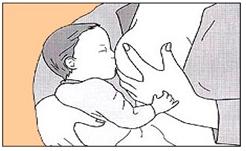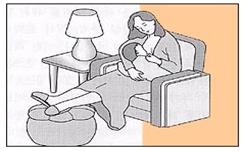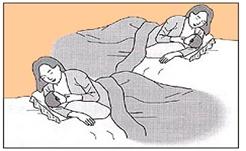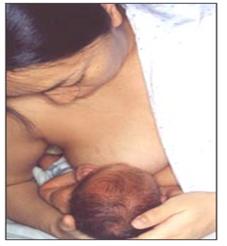젖을 먹일 때 수유모와 아기의 자세, Nursing position in the breastfeeding

그림 4-15. 가능한 한 편안한 자세로 아기를 폭신 안고 수유한다.
Copyright ⓒ 2011 John Sangwon Lee, MD., FAAP

그림 4-16. 두 다리를 쭉 뻗고 아기를 젖가슴에 바싹 끌어안고 수유한다.
Copyright ⓒ 2011 John Sangwon Lee, MD., FAAP

그림 4-17. 왼쪽으로 누워, 또는 오른쪽으로 누워 편안하게 수유한다.
Copyright ⓒ 2011 John Sangwon Lee, MD., FAAP
- 대부분의 산모들은 언제 어디서 그렇게 크게 소리 지르면서 겪었던 분만 진통을 말끔히 잊고 분만 후 바로 아주 건강하고 행복하고 아름답고 평화스럽게 보인다.
- 분만 후 갓난아기를 안고 젖을 먹이는 엄마 여성들처럼 아름답고 행복하고 평화스러운 이들은 이 세상에 없다고 생각한다.
- 그러나 일부 산모들은 임신 분만에서 오는 피로와 긴장으로 많이 지쳐 있을 수 있다.
- 더구나, 분만 중 분만부가 마취제, 진통제, 또는 그 외 다른 약물로 치료받기도 한다.
- 분만으로 불안했거나 때로는 임신, 분만 중 생긴 어떤 병을 치료받으면서 분만하기도 한다.
- 분만 후 몇 시간 동안 산모들의 일부는 정신적으로 육체적으로 많이 지쳐 있을 수 있다.
- 거기다가, 이제부터 한 아기의 엄마로서 한 가정의 주부로서, 남편의 부인으로 집안일을 전적으로 돌보면서 아기를 조건 없이 진심으로 사랑하면서 잘 보살피고 건강하게 양육해야 된다는 모정이 생긴다. 그 때 엄마의 책임감이 이만저만 크다는 것을 다시 한 번 생각할 때 일부의 산모들은 초조할 수 있다.
- 자연 분만을 한 후 1, 2, 3일 동안 병원 산모 입원실에서 분만 회복을 하는 것이 보통이다.
- 이때는 간호사들이 이것저것 많이 도와준다.
- 산모가 자신이 산후 건강관리를 보다 쉽게 할 수 있다.
- 아기를 목욕시킨다든지 기저귀를 갈아주는 등 신생아 양육, 건강관리도 그들의 도움을 받아 쉽게 할 수 있었다. 더러는 여러 가지 이유로 산후 회복을 하기위해 병원에 입원하고 있는 중 더 불안할 수 있다.
- 분만 후 수유모와 아기의 건강상태가 양호하면 분만대 위에서도 젖을 먹일 수 있고 산모 입원실 침대에서 갓 태어난 아기에게 젖을 바로 먹일 수 있다. 이 때 가능한 한 수유모에게 가장 편안한 자세로 모유를 수유 할 수 있게 도와준다.
- 앉아 수유를 할 수 있으면 등을 베개로 받치고 침대 위에 곧 바로 앉아 모유수유를 할 수 있다.
- 엄마의 앞가슴에 아기를 편안하게 포근히 안고 아기의 위아래 입술을 유륜에 대고, 엄마의 젖꼭지를 아기의 입안에 전부 넣고 젖을 먹이는 엄마, 아기의 모유수유 상호상관 자세는 상당히 중요하다.
- 아기의 배 살갗이 엄마의 배 살갗에 닿게, 아기의 머리를 엄마의 구부린 팔꿈치 안쪽 위에 놓고, 그 쪽의 아래팔과 손으로 아기의 엉덩이를 받혀 잡고, 아기를 안 잡은 다른 쪽의 손으로 젖 먹일 유방을 받쳐 젖꼭지가 아기의 입안으로 잘 들어가 젖꼭지를 입안에 옳게 물려 젖꼭지를 빨 수 있도록 해야 한다. (그림5-21 참조)
- 이 때 엄마의 한 쪽 손의 엄지는 유방의 위 부분에, 나머지 손가락은 유방의 아랫 부분에 놓는다.
- 그 다음 엄마의 젖꼭지를 아기의 입이나 입술에 대면 포유 반사로 아기는 입을 연다. 그리고 흡철 반사로 젖꼭지를 빨게 된다. 이 때 젖꼭지를 아기의 입의 바른 위치에 넣고 빨도록 다시 아기의 입의 위치를 재 조절해야 한다.
- 병원 산모 회복실에서 수유모가 누워서 아기에게 젖을 주고 싶으면 간호사의 도움을 받아 누워서 수유해도 되고, 앉아서 먹이고 싶으면 편히 앉아서 수유해도 된다.
- 분만 후 날이 갈수록 임신, 분만에서 온 피로와 회음절개수술로 생긴 통증이 점차로 덜해지고 몸을 움직이기가 더 쉬워진다.
- 분만 후 2~3일이 지나서부터 유선에서 변이 모유, 성숙 모유가 나오기 시작해서 젖이 불기 시작하고 분만 후 3~4일되면 젖이 제대로 분비되기 시작하면서 아기도 젖을 더 잘 빨아먹기 시작한다.
- 이때부터는 방바닥, 의자, 또는 침대 등에 편안한 자세로 앉아 젖을 먹여도 좋다.
- 수유모가 아주 피로할 때 특히 제왕절개수술 분만 후, 베이비 블루로 우울하거나, 앉아있을 때 불편하거나, 밤에 자다가 모유수유를 해야 할 때는 밤이나 낮에 편안히 누워 젖을 먹여도 된다.
- 그러나 누워 젖을 먹일 때는 수유를 하는 중 수유모가 잠들어 아기를 누르지 않도록 주의해야 한다.
- 엄마가 아기에게 젖을 줄 때는 아기를 수유모의 앞가슴에 포근히 안고 사랑스런 말을 하면서, 눈길 접촉으로 아기를 사랑해주고 또 아기로부터 사랑을 받으면서 신체 접촉으로 서로 사랑하면서 젖을 먹여야 한다.
- 엄마의 눈길 접촉사랑과 신체 접촉사랑을 받으면서 젖을 먹는 아기는 행복하고 젖 먹기를 더 좋아한다.
- 엄마의 젖을 먹는 아기가 필요로 하는 모든 영양분과 에너지를 엄마의 젖에서 공급받는 것도 중요하지만 엄마로부터 조건 없는 진정한 사랑을 받는다고 느낄 수 있게 모유수유를 하는 것은 아주 중요하다.
- 엄마가 아기에게 젖을 먹이면서 한 눈을 판다든지, 딴전을 핀다든지, 수유하는 것 말고 다른 일을 하면서 젖을 먹이면 아기의 마음은 퍽 아프다고 한다.
- 그래서 엄마는 아기를 진정으로 사랑하면서 먹이고 아기는 그런 사랑을 받으면서 엄마의 젖을 먹을 수 있는 시간과 공간이 필요하다.
- 엄마에게 더 사랑해 달라고 울 때도 있다. 아기가 조건 없이 진정한 사랑을 받고 있다고 느낄 수 있도록 사랑하면서 젖을 먹여야 한다.
- 제왕절개수술 분만을 받은 후나, 젖꼭지를 올바르게 물리고 젖을 먹는지 조심히 관찰해야 할 때, 상당히 큰 유방에서 젖을 빨아 먹일 때, 미숙 신생아나 저체중 신생에게 모유를 수유할 때 등 젖꼭지를 제대로 입안에 넣지 않고 젖을 빨아 먹일 때는 미식 축구공 잡는 식(그림5-24 참조)으로 아기를 안고 모유를 수유하면 아기가 젖꼭지를 더 잘 빨아먹을 수 있다.

사진 4-55. 미식 축구공을 잡는 식으로 아기를 안고 모유수유를 할 수 도 있다.
Copyright ⓒ 2011 John Sangwon Lee, MD., FAAP
Nursing position in the breastfeeding 젖을 먹일 때 수유모와 아기의 자세

Figure 4-15. Hold your baby in a comfortable position and breastfeed as much as possible. Copyright ⓒ 2011 John Sangwon Lee, MD., FAAP

Figure 4-16. Extend both legs and hold the baby tightly to the breast and breastfeed. Copyright ⓒ 2011 John Sangwon Lee, MD., FAAP

Figure 4-17. Lie on your left or right to breastfeed comfortably. Copyright ⓒ 2011 John Sangwon Lee, MD., FAAP
Most of the mothers have forgotten the labor pain they suffered when and where they shouted so loudly, and immediately after delivery they look very healthy, happy, beautiful and peaceful. I don’t think there are any people who are beautiful, happy, and peaceful like women who are mothers and breastfeeding babies after delivery. However, some mothers can be very tired of the fatigue and tension that comes from pregnancy and delivery.
Moreover, the delivery woman is sometimes treated with anesthetics, pain relievers, or other drugs during delivery.
They are anxious about a delivery, sometimes during pregnancy or delivery, while receiving treatment.
During the hours after delivery, some of the mothers can be very mentally and physically exhausted. In addition, from now on, as a mother of a baby, as a housewife in a family, and as a wife of her husband, while taking full care of her household chores, there is a premonition that she must take care of her baby well, take care of it, and raise it in a healthy way.
At that time, some mothers may be nervous when they think again that the mother’s sense of responsibility is only so much.
It is common to recover delivery in the maternal hospital room in a hospital for 1, 2 or 3 days after a natural delivery.
At this time, the nurses help a lot.
The mother can make it easier for her to take care of her postpartum health care. Newborn baby care and health care, such as bathing the baby or changing diapers, were easily done with their help. Some may be more anxious while being hospitalized for postpartum recovery for a number of reasons.
After delivery, if the nursing mother and the baby are in good health, breastfeeding can be done on the delivery table, and the newborn baby can be fed directly from the maternal hospital bed. At this time, it helps the nursing mother to breastfeed in the most comfortable position possible.
If you can sit and feed, you can support your back with a pillow and sit right on the bed to breastfeed.
A mother who comfortably holds her baby on her breasts or puts her baby’s upper and lower lips on the areola, and puts her mother’s nipples in the baby’s mouth and breastfeeds, the baby’s breastfeeding cross-correlation posture is very important.
Place the baby’s head on the inside of the mother’s bent elbow so that the baby’s tummy skin touches the mother’s tummy, hold the baby’s buttocks with its forearm and hand, and breastfeed with the other hand that does not hold the baby.
You need to support the breast so that the nipple fits into the baby’s mouth so that the nipple can be properly placed in the mouth to suck the nipple. (Refer to Figure 5-21) At this time, the thumb of one hand of the mother is placed on the upper part of her breast, and the other finger is placed on the lower part of her breast.
Then, when the mother’s nipple is placed on her baby’s mouth or lips, the baby opens the mouth with a mammalian reflex. She sucks her nipples with a sucker reflex. At this point, you need to readjust the position of the baby’s mouth so that her nipple is placed in the baby’s mouth and sucked. In the hospital maternal recovery room, if the nursing mother is lying down and wants to feed her baby, she can lie down and breastfeed with the help of a nurse.
As days go by after delivery, the fatigue from pregnancy and delivery, and pain caused by perineal surgery gradually decrease, and the body becomes easier to move.
Two to three days after delivery, transitional breast milk and mature breast milk begin to emerge from the mammary glands, and the milk begins to flow, and at 3 to 4 days after delivery, the milk begins to be secreted properly, and the baby begins to suck the milk better.
From this point on, you can sit on the floor, chair, or bed in a comfortable position and feed your breasts. When a nursing mother is very tired, especially after cesarean section delivery, baby blue is depressed, uncomfortable when sitting, or sleeping at night, and needing to breastfeed, you can lie down comfortably during the night or day to feed. However, when lying down and breastfeeding, care should be taken to prevent the nursing mother from falling asleep while breastfeeding and pressing the baby.
When a mother breastfeeds her baby, she embraces her baby in the breasts of her breastfeeding mother and speaks loving words, loving her baby with her eye contact, and receiving love from her baby while loving each other through physical contact. Should be fed. With her mother’s eye contact love and body contact love, the baby feeding her breasts is happier and prefers to breastfeed.
It is also important to get all the nutrients and energy a mother’s breastfeeding baby needs from her mother’s milk, but breastfeeding is so important that she feels that she is receiving true, unconditional love from her mother.
She says that when a mother breastfeeds her baby while she is breastfeeding, she does something other than opening one’s eyes, feeding, or breastfeeding, her baby’s heart hurts very much.
So the mother needs time and space to feed her baby while she truly loves it, and the baby receives that love while feeding her mother’s breast milk. There are times when the babies cry for her mother to love me more. The baby needs to breastfeed while her mother loves so that she can feel that the baby is unconditionally receiving true love.
After receiving a cesarean section, when it is necessary to carefully observe whether the nipple is properly placed and breastfeeding, when breastfeeding from a fairly large breast, or when breastfeeding to an immature newborn or underweight newborn, the nipple is not properly inserted into the mouth.
Holding and breastfeeding your baby by catching an American football ball when feeding (see Figure 5-24) will help your baby suck on the nipples better.

Photo 4-55. You can also hold a baby and breastfeed by catching an American football ball. Copyright ⓒ 2011 John Sangwon Lee, MD., FAAP
|
참조 문헌
Copyright ⓒ 2015 John Sangwon Lee, MD, FAAP 미국 소아과 전문의, 한국 소아청소년과 전문의 이상원 저 “부모도 반의사가 되어야 한다”-내용은 여러분들의 의사로부터 얻은 정보와 진료를 대신할 수 없습니다. “The information contained in this publication should not be used as a substitute for the medical care and advice of your doctor. There may be variations in treatment that your doctor may recommend based on individual facts and circumstances. “Parental education is the best medicine.” |